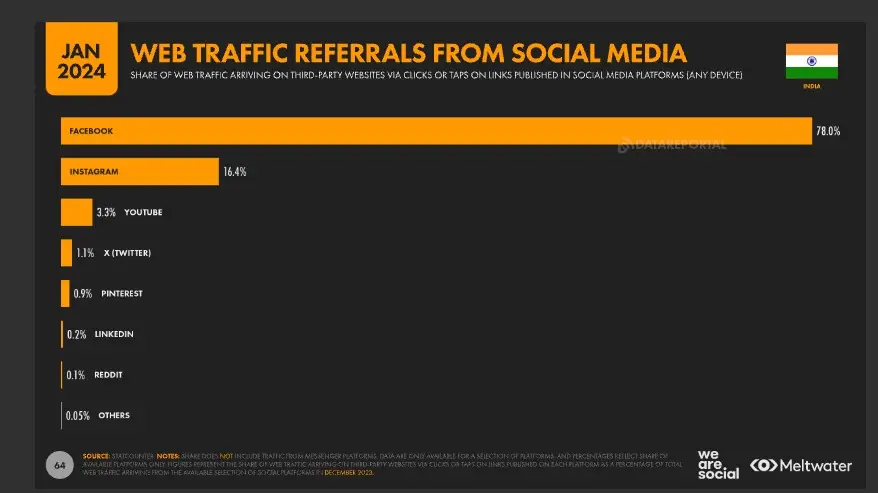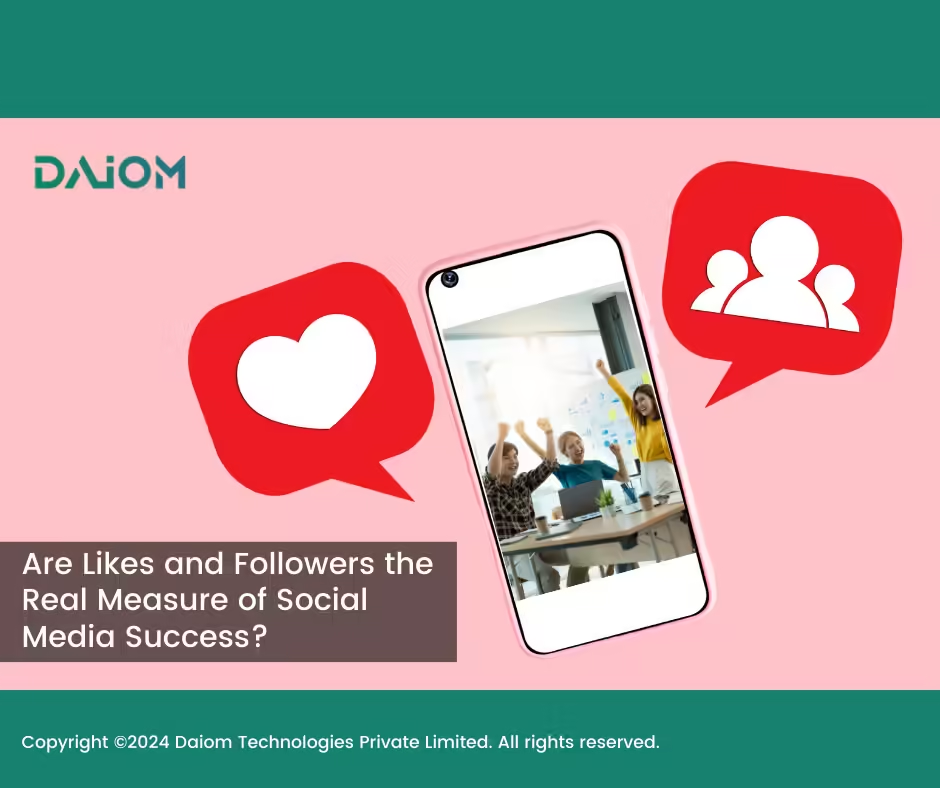Introduction
“More likes = success” mantra? Social media has exploded, but a major question still burning: are we celebrating empty numbers like followers and likes instead of measuring true business impact?
Worse: these metrics can be easily inflated! Marketers face constant pressure to justify social media investments, yet calculating genuine ROI often gets swept under the rug. We provide a break down of metrics, continue reading to find out
2. Quantifying Social Media's Importance
- With 5 billion social media users out of a global population of 8.08 billion, businesses can connect with vast numbers of potential customers worldwide, thanks to the extensive reach of social platforms.
- In India, users spend an average of 2 hours and 29 minutes daily on social media (Source: We Are Social, Global Digital Report 2024)
- Social media ad spend is projected to hit $219.8 billion in 2024, up by 9.3% from 2023. This surge is part of the rapid growth in digital ad spending, which now comprises over 70% (reaching $719 billion) of total ad expenditure, showcasing the dominance of online channels
- Businesses must prioritize digital and social media marketing to reach their target audience. For example, YouTube’s video ad revenues in India for 2022-23 hit approximately $690 million, marking a 20% y-o-y growth, its slowest in recent years. (Source: Financial Times)

- Facebook has a giant share in driving traffic to businesses’ websites and it has increased in recent years. Businesses can no longer afford to ignore any digital channel/platform and must learn the intricacies of each to fully utilise capabilities.


3. Components of Social Media Marketing
Social Media Marketing is a key component of Digital Marketing and it comprises of:
1. Own Channel Posts:
Think of any brand that has an active social media presence with a mix of picture posts, stories, reels or shorts, and videos. These are organic posts published directly by the brand on their own social media pages, and they offer several distinct advantages such as:
- Direct communication: You control the narrative and messaging, ensuring consistency with your brand voice and values. Eg Tanishq Jewellery
- Thought leadership: Share valuable industry insights, showcase expertise, and position yourself as a trusted authority. Eg Apple, Nike
- Personality & authenticity: Go beyond curated influencer content and connect with your audience on a deeper, more personal level. Eg Zomato
2. Performance Marketing:
- Performance marketing lends special focus on ROI. Unlike traditional marketing where outcomes are hazy, performance marketing operates on clear goals and tangible results.
- You only pay when specific actions happen, be it clicks, leads, sales, or other desired customer steps.
- This data-driven approach leverages diverse channels like affiliate marketing, PPC ads, social media engagement, and targeted search engine marketing, ensuring your message reaches the right audience at the right time – and delivers measurable results. In fact, PPC returns $2 for every $1 spent—a 200% ROI, and PPC ads in search results account for 45% of page clicks.(Source: WordStream)
3. User Generated Content
User-generated content (UGC) is any content—text, videos, images, reviews, etc.—created by people, rather than brands. Over time brands realised that paid UGC was a great way to have a lot of content associated with them and reduce the costs associated with building a campaign on their own.
In fact, 90% of consumers say authenticity is important when deciding which brands they like and support, and 60% say UGC is the most authentic form of content (Source: Nosto). Through UGC, brands can capture the voice of the consumer and incorporate it organically into their stories to achieve a high degree of familiarity and human element.
4. Influencer Marketing:
Influencers draw people in, creating tight-knit groups where trust and engagement is high, and the prevalence of content in regional/vernacular languages makes it easier for brands to cut across multiple segments of consumers at a lower cost. We have observed this with Zudio, Tata Trent’s low-cost fast fashion brand that has taken the Indian apparel market by storm and has been promoted highly through UGC! Especially in India where there is a major disruption in the influencer marketing scene, with an expected 3.5-4 million influencers in 2023. (Source: Business Insider)
With the number of influencers and other user-generated content on the rise, we must use social media analytics to understand the business impact of social media marketing.
4. Role of Analytics in social media marketing

Analytics is central to digital and social media marketing and provides numerous benefits. Data-driven organisations perform 23 times better at customer acquisition, 19 times more likely to stay profitable and almost 7 times more likely to retain customers. (Source: Forbes)
- Measuring and analyzing social media performance is crucial for optimizing campaigns and maximizing ROI. Social media analytics provide businesses with insights into how their campaigns are performing, what content is resonating with their audience, and where they can improve.
- Social media analytics also provide businesses with insights into their audience demographics, interests, and behaviours. This information can be used to target marketing campaigns more effectively and create content that is more likely to resonate with the target audience.
- Tracking competitor activity on social media can help identify trends and opportunities for differentiation. By understanding what the competitors are doing, businesses can stay ahead of the curve and develop unique and effective strategies.
Often in discourse, people obsess over reach and engagement metrics, especially followers and likes, however, to uncover the true impact of social media marketing, we must go beyond that and look closely at business KPIs

5. Steps to drive Business Impact through Analytics
Whilst there is no one-size-fits-all approach, there are three foundational steps to drive business impact from Social media.
- Install a Social Media Analytics Framework
It is important to begin by Stating your Objectives that make clear what you want to achieve with your social media marketing strategy. It is no mystery that marketing can help one achieve multiple goals:
- be it raising brand awareness,
- providing social proof or conducting product launch campaigns and demonstrations (unboxing videos, apparel and fits pictures etc.),
- providing a community and platform for customer advocacy,
- and finally to drive up business sales.
Once you have selected your goal the foundation is set for the entire framework and guides data collection process.
- Identify KPIs and align them with your business strategy
- Key Performance Indicators or KPIs are numbers that help determine whether a strategy is working. A single KPI is never enough to tell the whole story, but instead we require a combination of several to understand whether our campaign is nearing its objective. To drive business impact we look at KPIs that are related to business performance.
- Align the right KPIs to the objective and keep to gauge the effectiveness of your strategies. E.g. measuring the traffic generated to your website from an influencer’s post on Instagram and the conversion rate of these users.
- Additionally, define a percentage of the budget that goes into each piece of content that forms part of the campaign and measure it. The KPI will help you understand the ROI as per your target.
Here is a non-exhaustive list of major KPIs that marketers track:

- Experiment and Measure the Impact of Each Campaign
- To measure the impact of the campaign, you must define benchmarks. Benchmarks are the targets you define upfront, tailored to your specific campaign goals, budget, and industry. They could be a 10% boost in brand awareness, a 5% conversion rate, or even a 3x return on investment.
- Supposing you fall short of a target, it is an opportunity to reassess and examine the campaign and understand the reasons behind it. Powerful insights can be drawn when compared to competition benchmarks.
- Measuring the impact of your social media marketing campaign isn’t a one-shot deal. Think of it as a continuous feedback loop. Regularly monitor data, analyze the insights, and make adjustments.
6. Common ways of faking social media metrics
Vanity metrics like followers, likes and comments can be bought quite easily on the internet, and brands shouldn’t rely too much on them at face value. We must also be cautious when looking at metrics, as there are some ways of skewing the numbers that do no represent actual business impact and are misleading.
- Driving Giveaway Campaign: This involves a business or individual offering free prizes to social media users or subscribers to win in exchange for engagement-related activities like commenting, tagging other users, or sharing a particular post, story or video.
- Running Performance Marketing Campaigns: Businesses or individuals employ paid performance marketing for the specific purpose of increasing the number of followers their page or profile has.
- Paid Followers: Purchasing followers has become an all to common way to drive up the follower count; which goes to show that follower counts can often be misleading and our focus should always be on Business Imapct KPIs. Read about Click Farming over here.
7. Conclusion
Social media’s massive reach, high engagement, and growing advertising spending make it an essential platform for brands. By leveraging social media analytics brands can maximise the returns on spend, experiment with content and format, uncover new insights about consumer behavior and keep refining strategies.
At DAIOM, we have worked with multiple brands to help understand and improve the business impact of social media with our Consulting and Growth marketing services.
Feel free to get in touch with us saurabh@daiom.in or our team if you are interested to know how can you drive impact from social media.
Also, Check out our latest blog on How Generative AI In Marketing is Revolutionizing The Digital Landscape
Subscribe to our Newsletter.


